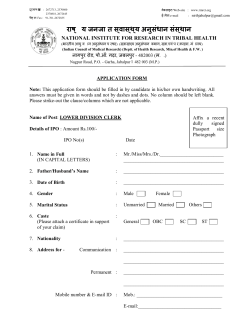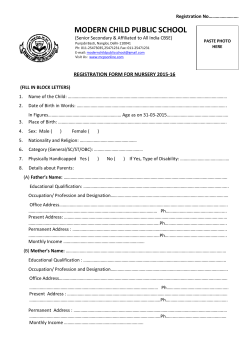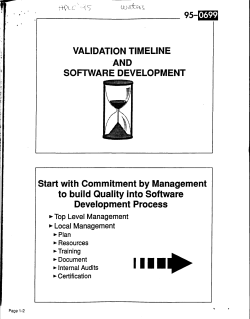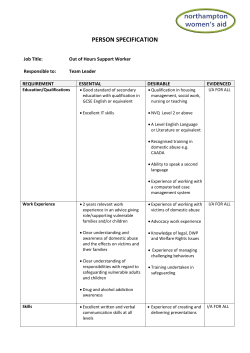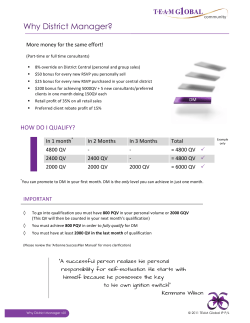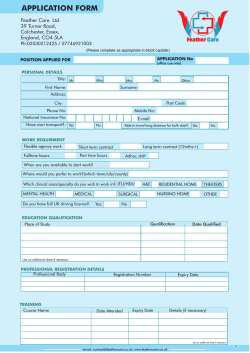
Quad LCMS QC Reference Material
[ CARE AND USE MANUAL ] Quad LCMS QC Reference Material CONT ENT S I. INT RODUC T ION I.INT RODUC T ION II. STO RAG E AND STABILIT Y III. QC RM USAG E IV. QC RM USAG E E X AM P L E V. SUMMA RY V I. O RD E RING INFO RMAT ION Quality Control Reference Materials (QCRM) contain mixtures of standards specifically chosen to provide an easy and reliable way to monitor the performance of chromatographic systems.1 Using a QCRM, you can be assured that your instrument and columns are ready to analyze your samples. Regular use of QCRMs provides an opportunity to benchmark your chromatographic systems and track performance over time, making it easier to proactively identify problems and resolve them faster. The Quad LCMS QCRM is an 8 component mix used to provide a comprehensive reference standard for use with Waters Quad detectors, like Xevo ® TQD, and SQD, with a wide variety of conditions and methods. Individual Components in the Quad LCMS QCRM Mix Component Empirical Formula Exact Mass (as [M+H] +) Exact Mass (as [M+H] -) Concentration for Analysis (µg/mL) Acetaminophen C 8 H9NO2 152.0712 Sulfaguanidine C7H10N4O2S 215.0603 213.0446 100 50 Sulfadimethoxine C12H14N4O4S 311.0814 309.0658 10 Val-Tyr-Val C19H29N3O5 380.2185 378.2029 25 Verapamil C 27H38N2O4 455.2910 6 Terfenadine C 32H41NO2 472.3216 6 Leucine-Enkephalin C 28 H37N5O7 556.2771 Reserpine C 33H40N2O9 609.2812 554.2615 The compounds in this mix give a mixture of responses in: ■■ ESI (+/-) ■■ Covers a wide range of m/z ■■ Optimized concentration to provide a more equal response by component in ESI+ mode ■■ Provides a separation in a range of chromatographic conditions used to benchmark instrument performance 25 18 [ CARE AND USE MANUAL ] II. STO RAG E AND STABILIT Y ■■ Qualification is the acquisition of data, using a mixture of standards such as a QCRM, on a benchmarked chromatographic system to determine if that system is still functioning properly and therefore is still “qualified” to receive analytical samples. When the QCRM performance parameter values measured during qualification are within the control limits determined during benchmarking, the system passes qualification and is deemed ready for use. Qualification is performed on each benchmarked chromatographic system at regular intervals and after any maintenance or repair. Setting a minimum qualification interval of “every workday morning” or “the first workday morning of the week” is strongly recommended. Labs that have a high sample load are encouraged to also do bracketing qualification runs. This is where qualification is done before and after each block of samples, especially during unmonitored runs (e.g., nights, weekends). When the “before” and “after” qualifications pass, there is high confidence that data is trustworthy for the bracketed block of samples. The data from benchmarking and subsequent qualification runs can also be entered into a control chart, allowing the analyst to evaluate the system performance over time.3 ■■ Troubleshooting is the sequence of activities performed to ascertain and correct deviations in chromatographic system performance. A qualification failure should trigger troubleshooting. The changes in performance parameter values (e.g., retention time shifts, and peak shape/area changes), observed using a QCRM can facilitate more rapid determination of the root cause of qualification failure. Use of a QCRM can thereby guide and accelerate the troubleshooting effort. After successful troubleshooting, a repeat of the qualification should then pass unless significant changes were made during troubleshooting. In such cases, re-calibration and re-benchmarking are likely needed. The standard comes in a flame sealed amber ampoule. It contains 1 mL in a matrix of 19% acetonitrile/81% water/0.008% formic acid. Due to the higher organic concentration, it is recommended, upon opening the ampoule, to immediately transfer the contents into a vial and then close the vial with a solid septum cap. Use Waters TruView™ LCMS Certified Vials with solid septum cap for best results. The standard mix is shipped at ambient temperatures. It is highly recommended that upon receipt, the standard should be refrigerated at 4 °C for short term and for long term stored frozen (-15 °C). Note: If any undissolved material is visible inside the ampoule/ vial, sonicate the unopened ampoule/vial until the material is completely dissolved. III. QC RM USAG E A QCRM is used to benchmark, qualify and troubleshoot a chromatographic system: ■■ Benchmarking is the acquisition of data, using a mixture of standards such as a QCRM, on a properly functioning chromatographic system with one or more new columns to determine normal performance parameter values (e.g., peak retention times, widths, intensities, areas, and tailing/asymmetry). Before benchmarking, a chromatographic system is confirmed to be in a properly functioning state by successfully completing [1] component level calibrations for all instrument modules and then [2] system level calibrations for the entire chromatographic system.2 System benchmarking is done by performing replicate analyses of the QCRM and calculating the mean and standard deviation for the desired performance parameter values. Upper and lower control limits (UCL, LCL) are then set. After benchmarking, these control limits are used to determine success or failure of system qualification. Benchmarking is generally completed on each new chromatographic system after it is installed and then repeated on each existing chromatographic system after it is calibrated.4 Quad LCMS QC Reference Material Care and Use 2 [ CARE AND USE MANUAL ] IV. QC RM USAG E E X AM P L E System: ACQUITY UPLC® with TQD Mass Spectrometer Column: CORTECS ® UPLC® C18, 1.6 μm, 2.1 x 50 mm Column temp.: 40° C Mobile phase A: 0.1% formic acid in water Mobile phase B: Acetonitrile Gradient: Time/min Flow rate mL/min %A %B Curve 0.0 0.5 100 0 – 3.5 0.5 0 100 6 4.5 0.5 100 0 11 Injection volume: 1 µL Sample: Quad LCMS QCRM (p/n: 186007362) Lot: W23121301 MS conditions: Full scan (Continuum) between 145-615 m/z with a scan time of 0.1 seconds Capillary voltage: 3.8 kV Cone voltage: 38 V Extractor: 3 RF lens: 0.0 Source temp.: 120 °C Desolvation temp.: 450 °C Desolvation flow: 1000 L/hr Cone flow: 30 L/hr CV-Cone Voltage, CE-Collision Energy, PI-Product Ions Compound Precursor CV PI 1 CE PI 2 CE Acetaminophen 152.06 35 110 15 93 25 Sulfaguanidine 211.1 25 156 15 92 25 Sulfadimethoxine 311 25 156 25 92 25 Val-Tyr-Val 380.2 25 136.1 25 235.2 15 Verapamil 455.4 35 165.2 35 303.3 25 Terfenadine 472.2 35 436.2 25 454.3 25 Leuciene-Enkephalin 556.2 35 397.2 15 425.2 15 Reserpine 609.3 35 195 35 397.2 15 Quad LCMS QC Reference Material Care and Use 3 [ CARE AND USE MANUAL ] V. SUMMA RY Quality Control Reference Materials are specifically designed to provide a controlled, consistent, and reliable way of monitoring system performance. Regular use of QCRMs to benchmark and qualify systems gives assurance that chromatographic results are high quality. Troubleshooting with QCRMs also minimize system downtimes. V I. O RD E RING INFO RMAT ION Description Part Number Quad LCMS QC Reference Material 186007362 LCMS QC Reference Material 186006963 Neutrals QC Reference Material 186006360 Reversed-Phase QC Reference Material 186006363 Preparative Chromatography Mix Standard 186006703 HILIC QC Reference Material 186007226 QDa QC Reference Material 186007345 2 UPC QC Reference Material 186007950 AutoPurification™ System Standard 716000765 References 1. A “chromatographic system” consists of the installed instrument components including all detectors (PDA, ELS, MS, etc.) plus the installed columns. 2. All calibrations are done as specified in the instrument manufacturer’s protocols. In some cases, there may be no system level calibration whereupon Benchmarking occurs directly after component level calibrations. 3. Benchmarking control limits are determined by each lab according to their data precision and reproducibility needs. Setting control limits of + 3 standard deviations about the mean value is a common practice. For more information on control limits and control charts, see Mullins, E.; Introductionto Control Charts in the Analytical Laboratory, Analyst 1994, 119, 369-375. 4. Consult the chromatographic system manufacturer’s recommendations regarding the frequency of calibration. Waters, T he Science of W hat’s Possible, Xevo, ACQUITY UPLC, UPLC and CORTECS are registered trademarks of Waters Corporation. TruView and AutoPurification are trademarks of Waters Corporation. All other trademarks are the property of their respective owners. ©2015 Waters Corporation. Produced in the U.S.A. February 2015 720005288EN TC-PDF Waters Corporation 34 Maple Street Milford, MA 01757 U.S.A. T: 1 508 478 2000 F: 1 508 872 1990 www.waters.com
© Copyright 2025


